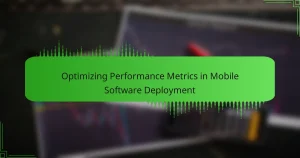Docker is a containerization platform that offers significant advantages for mobile software deployment. It ensures consistent application performance across development, testing, and production environments. By simplifying the deployment process, Docker allows developers to package applications and their dependencies into containers that can be easily shared and deployed on various platforms. Additionally, Docker enhances scalability, enabling quick adjustments based on user demand, and improves resource efficiency by utilizing hardware more effectively than traditional virtual machines. It also supports rapid iteration and deployment, allowing for swift updates with minimal downtime, while facilitating collaboration among development teams working on different application components.

What are the Advantages of Using Docker for Mobile Software Deployment?
Docker offers several advantages for mobile software deployment. First, it ensures consistency across different environments. This means that applications run the same way on development, testing, and production systems. Second, Docker simplifies the deployment process. It allows developers to package applications and dependencies into containers. These containers can be easily shared and deployed across various platforms.
Third, Docker enhances scalability. It enables developers to quickly scale applications up or down based on demand. This flexibility is crucial for mobile applications that may experience varying levels of user traffic. Fourth, Docker improves resource efficiency. Containers use fewer resources than traditional virtual machines, allowing for better utilization of hardware.
Additionally, Docker supports rapid iteration and deployment. Developers can make changes to applications and deploy them quickly without significant downtime. Finally, Docker facilitates collaboration among teams. It allows different teams to work on separate components of an application without conflicts. These advantages make Docker a valuable tool for mobile software deployment.
How does Docker streamline the mobile software deployment process?
Docker streamlines the mobile software deployment process by providing containerization technology. This technology allows developers to package applications and their dependencies into isolated environments. Each container runs consistently across different computing environments. This reduces the chances of compatibility issues during deployment. Docker also enables faster deployment cycles through its lightweight nature. Containers can be spun up or down quickly, allowing for rapid testing and iteration. Additionally, Docker’s orchestration tools simplify managing multiple containers. This enhances scalability and resource allocation during deployment. Overall, Docker improves efficiency and reliability in mobile software deployment.
What specific features of Docker enhance deployment efficiency?
Docker enhances deployment efficiency through several specific features. First, it uses containerization to package applications and their dependencies together. This ensures consistent environments across various stages of development and production. Second, Docker’s lightweight containers start quickly, reducing the time needed for deployment. Third, Docker enables easy scalability by allowing multiple containers to run simultaneously. Fourth, it supports version control for images, facilitating rollback to previous versions if needed. Lastly, Docker’s orchestration tools, like Docker Swarm and Kubernetes, automate deployment processes, further increasing efficiency. These features collectively streamline the deployment workflow, reducing downtime and improving overall productivity.
How does Docker improve consistency across environments?
Docker improves consistency across environments by encapsulating applications and their dependencies in containers. These containers ensure that the software runs the same way, regardless of where it’s deployed. Docker eliminates the “it works on my machine” problem by providing a standardized environment. Each container includes everything needed to run the application, including libraries and system tools. This leads to fewer discrepancies between development, testing, and production environments. As a result, teams can deploy applications faster and with greater confidence. According to a 2020 survey by Docker, 76% of developers reported improved consistency in application performance across environments after adopting Docker.
What are the cost benefits of using Docker for mobile software deployment?
Using Docker for mobile software deployment offers significant cost benefits. It reduces infrastructure costs by allowing multiple applications to run on the same server. This leads to more efficient resource utilization. Docker’s containerization minimizes the overhead associated with traditional virtual machines. This results in lower operational costs. Deployment time is also decreased, leading to faster time-to-market. Faster deployment can translate to increased revenue opportunities. Additionally, Docker simplifies scaling applications, which can reduce costs associated with over-provisioning resources. Overall, these factors contribute to a more cost-effective deployment strategy.
How does Docker reduce resource consumption?
Docker reduces resource consumption by utilizing containerization technology. This approach allows multiple applications to run on a single operating system kernel. Unlike traditional virtual machines, containers share the host OS, which minimizes overhead. As a result, Docker containers start quickly and use fewer resources. This efficiency leads to improved performance and scalability. According to studies, Docker can reduce resource usage by up to 50% compared to virtual machines. Additionally, containers are lightweight, allowing for more applications to be deployed on the same hardware. This optimization is crucial for mobile software deployment, where resource efficiency is essential.
What are the long-term savings associated with Docker implementation?
Docker implementation can lead to significant long-term savings. These savings primarily stem from reduced infrastructure costs. Docker containers are lightweight, allowing for more efficient resource utilization. This efficiency can lead to lower server costs and energy consumption.
Additionally, Docker streamlines the development process. Faster deployment times reduce labor costs associated with software development. According to a study by the DevOps Research and Assessment (DORA), organizations using containerization report deployment frequency improvements of up to 200 times.
Moreover, Docker’s ability to facilitate continuous integration and delivery minimizes downtime. This results in higher productivity and less revenue loss during software updates.
Overall, the long-term savings from Docker implementation include lower operational costs, reduced labor expenses, and increased revenue through improved efficiency.
Why is scalability important in mobile software deployment?
Scalability is crucial in mobile software deployment because it ensures the application can handle varying loads effectively. As user demand grows, scalable software can accommodate more users without performance degradation. This flexibility allows businesses to respond to market changes swiftly. For instance, applications that can scale efficiently experience less downtime during traffic spikes. According to a report by Gartner, businesses that prioritize scalability can reduce their operational costs by up to 30%. Thus, scalability directly impacts user satisfaction and business success in a competitive landscape.
How does Docker facilitate scaling mobile applications?
Docker facilitates scaling mobile applications by providing containerization for consistent environments. This allows developers to create, deploy, and manage applications in isolated containers. Each container can run independently, enabling efficient resource utilization. Docker’s orchestration tools, such as Kubernetes, automate the scaling process. These tools manage container deployment across multiple servers. This ensures that applications can handle increased loads seamlessly. According to a study by the Cloud Native Computing Foundation, 78% of organizations reported improved scaling capabilities using Docker. This highlights its effectiveness in managing mobile application demands.
What are the implications of scalability on user experience?
Scalability directly impacts user experience by determining how well an application can handle increased loads. A scalable application maintains performance levels as user demand grows. For instance, applications that scale effectively can provide consistent response times even during peak usage. This reliability enhances user satisfaction and retention. Conversely, poor scalability can lead to slow load times and crashes, negatively affecting user experience. Research shows that 53% of mobile users abandon apps that take longer than three seconds to load. Therefore, ensuring scalability is crucial for optimizing user experience in mobile software deployment.
How does Docker enhance collaboration among development teams?
Docker enhances collaboration among development teams by providing consistent environments across different stages of development. It allows developers to create, test, and deploy applications in containers that encapsulate all dependencies and configurations. This eliminates the “it works on my machine” problem commonly faced in software development. Teams can share these containers, ensuring that everyone works with the same setup. Moreover, Docker simplifies the onboarding process for new team members by providing pre-configured environments. According to a survey by Docker, 94% of developers reported improved collaboration when using container technology. This shared environment fosters better communication and reduces integration issues, ultimately speeding up the development process.
What role does Docker play in continuous integration and delivery?
Docker facilitates continuous integration and delivery by enabling consistent and reproducible environments. It allows developers to package applications and their dependencies into containers. These containers can run uniformly across different stages of development, testing, and production. This reduces the “it works on my machine” problem, ensuring that code behaves the same everywhere. Docker integrates seamlessly with CI/CD tools like Jenkins and GitLab CI. This integration automates the build, test, and deployment processes. As a result, teams can deliver software faster and with fewer errors. Docker’s lightweight nature also speeds up the provisioning of environments, enhancing overall efficiency.
How does Docker support version control in mobile applications?
Docker supports version control in mobile applications by allowing developers to create containerized environments for each application version. Each Docker image can represent a specific version of the application. This isolation ensures that different versions do not interfere with each other. Developers can easily roll back to previous versions by deploying earlier Docker images. Docker’s layered file system also enables efficient storage and retrieval of changes between versions. Furthermore, version tags can be used to label images, making it simpler to track and manage different releases. These features collectively facilitate a streamlined version control process in mobile application development.
What security advantages does Docker provide for mobile software deployment?
Docker provides enhanced security for mobile software deployment by isolating applications in containers. Each container operates independently, reducing the risk of vulnerabilities spreading between applications. Docker employs a layered file system, which minimizes the attack surface by only exposing necessary components. It also enables the use of immutable infrastructure, meaning that once a container is deployed, it cannot be altered, preventing unauthorized changes. Additionally, Docker simplifies the management of dependencies, ensuring that applications run consistently and securely across different environments. The use of namespaces and control groups further enhances security by limiting resource access and visibility. These features collectively contribute to a more secure deployment process for mobile applications.
How does containerization improve application security?
Containerization improves application security by isolating applications within their own environments. This isolation limits the access that applications have to the underlying system. Each container operates independently, reducing the risk of vulnerabilities spreading between applications. Additionally, containers can be configured with specific security policies. These policies can enforce restrictions on network access and resource usage. Moreover, container images can be scanned for vulnerabilities before deployment. This proactive approach helps identify and mitigate security risks early. According to a report by the National Institute of Standards and Technology (NIST), containerization can significantly reduce the attack surface of applications. This reduction enhances overall security posture in deployment scenarios.
What best practices should be followed to maintain security in Docker?
To maintain security in Docker, follow best practices such as using minimal base images. Minimal images reduce the attack surface by containing fewer vulnerabilities. Regularly update images to incorporate security patches. This practice helps in addressing known vulnerabilities. Implement user namespaces to limit container privileges. Limiting privileges minimizes potential damage if a container is compromised. Use Docker’s built-in security features like AppArmor or SELinux for additional protection. These features enforce security policies on containers. Regularly scan images for vulnerabilities using tools like Clair or Trivy. Scanning helps identify and mitigate risks before deployment. Finally, avoid running containers as root to enhance security. Running as a non-root user reduces the risk of privilege escalation attacks.
How can organizations effectively implement Docker for mobile deployment?
Organizations can effectively implement Docker for mobile deployment by following a structured approach. First, they should define their application architecture and containerization strategy. This involves identifying the components that can be containerized. Next, organizations need to create Docker images for their mobile applications. These images must include all dependencies required for the applications to run smoothly.
After creating the images, organizations should use Docker Compose to manage multi-container applications. This tool simplifies the configuration of services and dependencies. Additionally, organizations should set up a Continuous Integration/Continuous Deployment (CI/CD) pipeline. This pipeline automates the building, testing, and deployment of Docker containers.
Finally, organizations must utilize orchestration tools like Kubernetes for scaling and managing containers in production. Kubernetes provides robust features for load balancing and service discovery. By following these steps, organizations can streamline their mobile deployment process and enhance application performance.
What steps are involved in transitioning to Docker for mobile applications?
Identify the mobile application architecture and dependencies. Assess the current environment and requirements for the application. Install Docker on the development machine. Create a Dockerfile to define the application environment. Build the Docker image using the Dockerfile. Test the Docker image locally to ensure functionality. Push the Docker image to a container registry. Deploy the Docker container to the target environment.
What common challenges do organizations face when adopting Docker?
Organizations face several common challenges when adopting Docker. One major challenge is the complexity of container orchestration. Managing multiple containers requires expertise in tools like Kubernetes. Another challenge is ensuring security within containers. Vulnerabilities can arise if images are not properly scanned. Additionally, organizations may struggle with integration into existing workflows. Legacy systems can complicate the transition to a containerized environment. Resource management is also a concern, as containers can consume significant system resources if not monitored. Finally, training staff on Docker best practices can be time-consuming. These challenges can hinder the successful implementation of Docker in an organization.
What are the best practices for optimizing Docker in mobile software deployment?
Use lightweight base images to reduce the overall size of Docker containers. Smaller images lead to faster deployment and reduced resource consumption. Optimize Dockerfiles by minimizing the number of layers and combining commands. This practice enhances build efficiency and speeds up the image creation process. Implement multi-stage builds to separate build dependencies from runtime dependencies. This approach results in cleaner final images and improved security.
Leverage Docker caching to speed up builds by reusing unchanged layers. This can significantly reduce build times, especially in continuous integration environments. Regularly update images to incorporate security patches and improvements. Keeping images up-to-date minimizes vulnerabilities and enhances performance. Utilize Docker Compose for managing multi-container applications effectively. This simplifies orchestration and configuration management for complex deployments.
Monitor container performance using tools like Prometheus and Grafana. These tools provide insights into resource usage and help identify bottlenecks. Finally, ensure proper networking configurations to facilitate communication between containers. Efficient networking is crucial for optimizing performance in mobile software deployments.
How can performance be monitored and improved in Docker containers?
Performance in Docker containers can be monitored and improved using various tools and practices. Tools like Prometheus and Grafana provide real-time monitoring of container performance metrics. These tools collect data on CPU usage, memory consumption, and network I/O.
Additionally, Docker’s built-in commands, such as `docker stats`, can be used for quick performance insights. Resource limits can be set with flags like `–memory` and `–cpus` to prevent resource overutilization.
Optimizing Dockerfiles helps improve performance by reducing image size and build time. Using multi-stage builds can create leaner images. Regularly updating images ensures performance benefits from the latest optimizations.
Implementing container orchestration with Kubernetes can enhance scalability and load balancing. These practices collectively ensure effective monitoring and continuous improvement of performance in Docker containers.
What tools can aid in managing Docker for mobile applications?
Docker Compose facilitates defining and running multi-container Docker applications. It simplifies configuration through a YAML file. Kubernetes offers orchestration for managing containerized applications at scale. It automates deployment, scaling, and operations of application containers. Portainer provides a user-friendly interface for managing Docker environments. It helps visualize and control containers easily. Jenkins supports continuous integration and continuous deployment (CI/CD) for Dockerized applications. It automates the build and deployment process. These tools enhance the efficiency of managing Docker for mobile applications.
Docker is a containerization technology that offers numerous advantages for mobile software deployment. It ensures consistency across development, testing, and production environments, simplifies the deployment process, and enhances scalability to accommodate varying user demands. Additionally, Docker improves resource efficiency, supports rapid iteration, and fosters collaboration among development teams. This article explores the key benefits of using Docker, including its impact on deployment efficiency, cost savings, security, and best practices for implementation in mobile application development.


